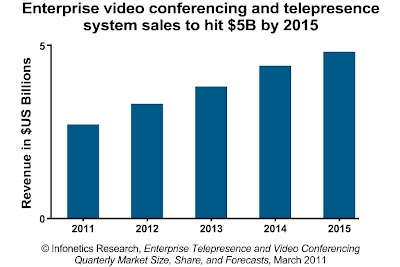If you're like many multinational business leaders today, then your company exists within a complex network of vendors, customers and other collaborators. This business ecosystem is as vital to you as your employees and intellectual property. Keeping it healthy helps you maintain and grow your market share, navigate challenging economic conditions, and explore new business opportunities.
In many commercial scenarios, conducting international business and staying in touch with all your key stakeholders requires regular face-to-face communications. But sometimes you can accomplish your personal interaction objectives without the need to travel to distant places.
Infonetics Research released its current Enterprise Telepresence and Video Conferencing report, which provides insight and analysis of dedicated videoconference infrastructure and endpoints -- which includes the latest immersive telepresence applications.
Collaborating in a Global Distributed Organization
"Communicating via video continues to be one of the top trends, as evidenced by strong growth in the enterprise video market. Businesses worldwide are looking for richer means of communications with their employees, partners, and customers, and enterprise videoconferencing and telepresence solutions are a natural fit," said Matthias Machowinski, directing analyst for enterprise networks and video at Infonetics Research.
According to the findings from their latest market study, Infonetics says they believe that the biggest winners in the enterprise communications market will be those who offer solutions that are multi-modal, visual (video-based), and support the collaboration requirements of globally distributed organizations.
Highlights of the Infonetics market study include:
In many commercial scenarios, conducting international business and staying in touch with all your key stakeholders requires regular face-to-face communications. But sometimes you can accomplish your personal interaction objectives without the need to travel to distant places.
Infonetics Research released its current Enterprise Telepresence and Video Conferencing report, which provides insight and analysis of dedicated videoconference infrastructure and endpoints -- which includes the latest immersive telepresence applications.
Collaborating in a Global Distributed Organization
"Communicating via video continues to be one of the top trends, as evidenced by strong growth in the enterprise video market. Businesses worldwide are looking for richer means of communications with their employees, partners, and customers, and enterprise videoconferencing and telepresence solutions are a natural fit," said Matthias Machowinski, directing analyst for enterprise networks and video at Infonetics Research.
According to the findings from their latest market study, Infonetics says they believe that the biggest winners in the enterprise communications market will be those who offer solutions that are multi-modal, visual (video-based), and support the collaboration requirements of globally distributed organizations.
Highlights of the Infonetics market study include:
- Annual enterprise video conferencing and telepresence system revenue grew 18 percent in 2010 to $2.2 billion worldwide.
- Infonetics expects the enterprise video conferencing and telepresence market to more than double by 2015, when it will reach $5.0 billion.
- Due to their versatility, multi-purpose room systems account for the majority of enterprise video conferencing equipment.
- Immersive telepresence systems are expected to have the highest growth rates of all video conferencing equipment.
- Based upon their low cost and availability on PBXs, software-based endpoints out-ship hardware by 10:1
- The acquisition of Tandberg propelled Cisco to the top position – based on the overall enterprise video conferencing market, with 50 percent of revenue in 2010.
- Polycom maintains its second position for revenue, and leads for units shipped.

